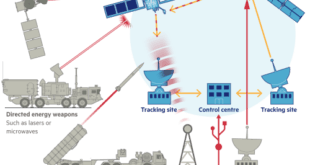Introduction: In the ever-evolving landscape of modern warfare, the U.S. Air Force stands poised at the forefront, armed not only with cutting-edge technology but also with strategic doctrine designed to seize and maintain dominance across all domains. With the release of its latest doctrine on Electromagnetic Spectrum (EMS) Operations on …
Read More »Advancing Aviation: The Rise of More Electric Aircraft (MEA) and All Electric Aircraft technologies
In recent years, the aviation industry has been undergoing a significant transformation driven by technological advancements and a growing emphasis on sustainability. One of the most promising developments in this regard is the emergence of More Electric Aircraft (MEA) and All Electric Aircraft (AEA). These innovative aircraft designs leverage new …
Read More »Unveiling the Future: THz Nano-Resonator Technology and Its Impact on 6G Communications
Introduction In the dynamic landscape of telecommunications, the quest for faster, more reliable connectivity is unending. As the world anticipates the dawn of 6G communications, the spotlight shines on a groundbreaking technology: Terahertz (THz) nano-resonators. These miniature devices hold immense promise in harnessing THz electromagnetic waves to revolutionize communication, sensing, …
Read More »The Emergence of Satellite Jammers: A New Chapter in Space Warfare
In contemporary military operations, access to the electromagnetic (EM) spectrum is indispensable for modern armed forces. However, with adversaries seeking to gain dominance in this domain, the EM spectrum has evolved from being merely an enabler to becoming a primary battleground, equivalent to land, sea, air, and space operations. With …
Read More »Securing Military Navigation: The Evolution of GNSS Anti-Jamming Systems
Introduction: In modern warfare, navigation and positioning are critical components for military operations. The Global Navigation Satellite System (GNSS) has become a cornerstone technology for providing accurate and reliable positioning information. However, the widespread use of GNSS also makes it vulnerable to deliberate interference, such as jamming and spoofing, by …
Read More »Russia’s Electronic Warfare Dominance: A Comprehensive Overview
In recent years, Russia has emerged as a global leader in electronic warfare (EW) capabilities, boasting a wide range of offensive and defensive systems across airborne, unmanned aerial vehicle (UAV), and ground-based platforms. This sophisticated EW arsenal, developed and deployed by the Russian military, has been instrumental in various conflicts …
Read More »Securing the Spectrum: Unveiling the Advanced Dynamic Spectrum Reconnaissance (ADSR) in AI-Driven Electronic Warfare
Introduction: U.S. soldiers in Europe have recently conducted field tests of the Advanced Dynamic Spectrum Reconnaissance (ADSR), an artificial intelligence (AI) system designed to enhance wireless network security in contested areas, as reported by the 7th Army Training Command. The ADSR, developed in collaboration with the Pathfinder program and researchers …
Read More »Revolutionizing Semiconductor Design: Unleashing the Power of Generative Artificial Intelligence (GenAI)
Introduction: In the ever-evolving landscape of technology, the semiconductor industry stands as a cornerstone, driving innovation in electronic devices. As the demand for advanced chips continues to surge, the complexity of semiconductor electronic design automation (EDA) has reached unprecedented levels. Enter Generative Artificial Intelligence (GenAI), a cutting-edge capability poised to …
Read More »The Synergy of Power: Integrated Cyber and Electronic Warfare Technologies
Introduction: In the rapidly evolving landscape of modern warfare, the convergence of cyber and electronic warfare technologies has emerged as a force multiplier, reshaping the dynamics of conflicts and defense strategies. The integration of these two domains creates a formidable synergy, providing nations with unprecedented capabilities to both defend against …
Read More »Unveiling the Power of Rugged Electronics: Applications and Market Trends
Introduction: The world is getting tougher, and so are the electronics we rely on. From the scorching deserts to the icy tundras, from the depths of the ocean to the outer reaches of space, there are places where ordinary electronics simply won’t cut it. Rugged electronics are designed to withstand …
Read More » International Defense Security & Technology Your trusted Source for News, Research and Analysis
International Defense Security & Technology Your trusted Source for News, Research and Analysis


